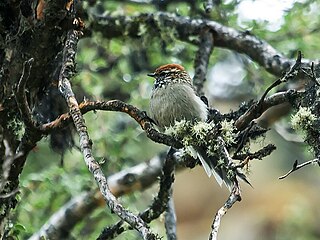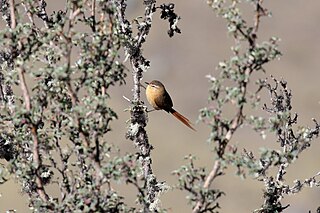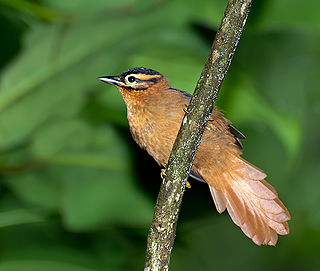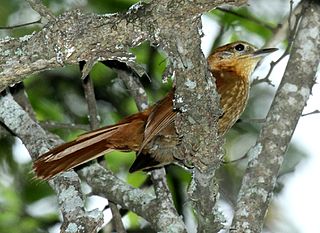
The plain-mantled tit-spinetail is a small passerine bird of South America in the Furnariinae subfamily of the ovenbird family Furnariidae. It is found in Argentina, Bolivia, Chile, and Peru.

The common miner is a passerine bird in the subfamily Sclerurinae, the leaftossers and miners, of the ovenbird family Furnariidae. It is found in Argentina, Bolivia, Brazil, Chile, Peru, and Uruguay.

Tit-spinetails are small passerine birds of the genus Leptasthenura, belonging to the ovenbird family Furnariidae. They are found in South America, particularly the southern and Andean parts of the continent. They are somewhat similar to birds of the tit family in their shape and feeding behaviour, hence the first part of their name. The "spinetail" part of their name refers to their long, pointed tail feathers. Tit-spinetails have short rounded wings, short pointed bills and are mainly brown in colour. Their nests are built in holes or in the old nests of other birds.

The sharp-tailed streamcreeper(Lochmias nematura), is a passerine bird of South America in the Furnariinae subfamily of the ovenbird family Furnariidae. Alternate names include streamside Lochmias, sharp-tailed creeper, and simply streamcreeper. It is found in Panama and every mainland South American country except Chile, French Guiana, and Suriname.

The chestnut-winged hookbill is a species of bird in the Furnariinae subfamily of the ovenbird family Furnariidae. It is found in Bolivia, Brazil, Colombia, Ecuador, and Peru.

The buff-winged cinclodes is a species of bird in the Furnariinae subfamily of the ovenbird family Furnariidae. It is found in Argentina, Brazil, Chile, Paraguay, Uruguay and as a vagrant on the Falkland Islands.

The canebrake groundcreeper is a species of bird in the Furnariinae subfamily of the ovenbird family Furnariidae. It is found in Argentina, Brazil, and Paraguay.

The band-tailed earthcreeper is a species of bird in the Furnariinae subfamily of the ovenbird family Furnariidae. It is found in Argentina and Chile.

The campo miner is a Vulnerable species of bird in the subfamily Sclerurinae, the leaftossers and miners, of the ovenbird family Furnariidae. It is found in Bolivia and Brazil, and as a vagrant in Paraguay.

The slender-billed miner is a species of bird in the subfamily Sclerurinae, the leaftossers and miners, of the ovenbird family Furnariidae. It is found in Argentina, Bolivia, Ecuador, and Peru.

The brown-capped tit-spinetail is a species of bird in the Furnariinae subfamily of the ovenbird family Furnariidae. It is found in Argentina and Bolivia.

The rusty-crowned tit-spinetail is a species of bird in the Furnariinae subfamily of the ovenbird family Furnariidae. It is endemic to Peru.

The striolated tit-spinetail is a species of bird in the Furnariinae subfamily of the ovenbird family Furnariidae. It is endemic to Brazil.

The white-browed tit-spinetail is an Endangered species of bird in the Furnariinae subfamily of the ovenbird family Furnariidae. It is endemic to Peru.

The tawny tit-spinetail is a species of bird in the Furnariinae subfamily of the ovenbird family Furnariidae. It is found in Argentina, Bolivia, and Peru.

The black-capped foliage-gleaner is a species of bird in the Furnariinae subfamily of the ovenbird family Furnariidae. It is found in Argentina, Brazil, and Paraguay.

The chestnut-winged foliage-gleaner is a species of bird in the Furnariinae subfamily of the ovenbird family Furnariidae. It is found in Bolivia, Brazil, Colombia, Ecuador, Peru, and Venezuela.

The ochre-breasted foliage-gleaner is a species of bird in the Furnariinae subfamily of the ovenbird family Furnariidae. It is found in Argentina, Brazil, and Paraguay.

The wren-like rushbird is a species of bird in the Furnariinae subfamily of the ovenbird family Furnariidae. It is found in Argentina, Bolivia, Brazil, Chile, Paraguay, Peru, and Uruguay.

The rufous-necked foliage-gleaner is a Vulnerable species of bird in the Furnariinae subfamily of the ovenbird family Furnariidae. It is found in Ecuador and Peru.























